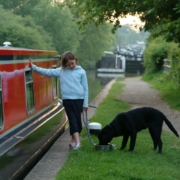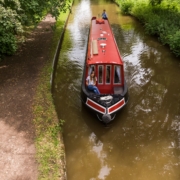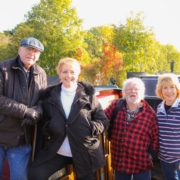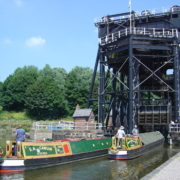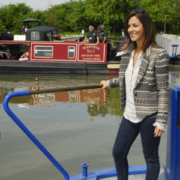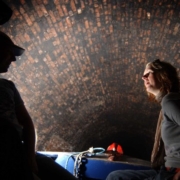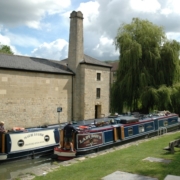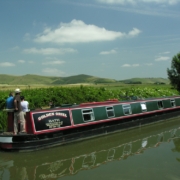A is for Anderton Boat Lift – also known as the ‘Cathedral of the Canals’, this fascinating example of Victorian engineering, which looks like a giant iron spider, provides a 15-metre vertical link between the Trent & Mersey Canal and River Weaver Navigation. Designed by Edwin Clark and opened in 1875, it consists of two caissons, each large enough to take a barge or pair of narrowboats.
B is for Bingley Five-Rise Locks – completed in 1774, this spectacular staircase of locks on the Leeds & Liverpool Canal, 17 miles from Leeds, raises (or lowers) boats 18 metres in five cavernous chambers. The locks open directly from one to another, with the top gate of one forming the bottom gate of the next.
C is for Caen Hill Flight – with 16 of its 29 locks falling in a straight line, the Caen Hill flight of locks on the Kennet & Avon Canal at Devizes in Wiltshire is visually the most impressive in the country. The locks were the final link in the Kennet & Avon Canal’s construction, opening in 1810. By 1950 they had become derelict but after a major restoration effort, they were reopened HM The Queen in 1990.
D is for Docks – docks were built to accommodate ships and store cargoes and many can be visited by boat. Among the best known are London Docklands, once the busiest in the world and Liverpool’s Albert Dock, a World Heritage site, both now home to stylish restaurants, bars and attractions.
E is for Economy – over £1½ billion is spent by visitors to the waterways each year on goods and services, supporting 54,000 jobs, so a canal boat holiday helps support the local economy.
 F is for Falkirk Wheel – said to be Scotland’s most exciting example of 21st century engineering, The Falkirk Wheel is the world’s first and only rotating boat lift. Standing at a height of 35 metres, it moves boats between the Union Canal and Forth & Clyde Canal, replacing a flight of 11 locks which had been dismantled in 1933. It can carry 600 tonnes, including eight or more boats and uses just 1.5KWh of energy to turn – the same amount as it would take to boil eight household kettles.
F is for Falkirk Wheel – said to be Scotland’s most exciting example of 21st century engineering, The Falkirk Wheel is the world’s first and only rotating boat lift. Standing at a height of 35 metres, it moves boats between the Union Canal and Forth & Clyde Canal, replacing a flight of 11 locks which had been dismantled in 1933. It can carry 600 tonnes, including eight or more boats and uses just 1.5KWh of energy to turn – the same amount as it would take to boil eight household kettles.
G is for Gongoozling – the leisurely watching of boats, often passing through a lock. The word may have arisen from the Lincolnshire dialect – ‘gawn’ and ‘goozle’, both meaning to stare or gape.
H is for History – the canals were built to transport goods and materials to support the Industrial Revolution. For example, the Duke of Bridgewater commissioned James Brindley to build the Bridgewater Canal, which opened in 1761 and moved the coal he mined from Lancashire to Manchester. Today, thousands of historic structures, many of them over 200 years old, make up the waterway system.
I is for Iron Trunk Aqueduct – built in 1811 by canal engineer Benjamin Beavan, the Iron Trunk Aqueduct is a magnificent Georgian structure and an impressive example of canal engineering. Standing at over 10 metres high, its two cast iron troughs carry the Grand Union Canal over the River Ouse between Wolverton and Cosgrove in Buckinghamshire.
J is for Jessop – William Jessop (1745-1814) was one of the great canal engineers and considered to be the greatest expert on canal and river navigations of his time. He was the engineer on the Grand Union, Rochdale and Llangollen canals. He was also responsible for the East India docks in London and dock improvements in Bristol.
 K is for Kennet & Avon Canal – passing through spectacular scenery, the 87-mile long Kennet & Avon Canal is one of Britain’s most popular waterways. Linking the River Thames and the Bristol Avon, it travels through some of the nation’s best loved landscapes, including West Berkshire’s Area of Outstanding Natural Beauty and the southern tip of the Cotswolds.
K is for Kennet & Avon Canal – passing through spectacular scenery, the 87-mile long Kennet & Avon Canal is one of Britain’s most popular waterways. Linking the River Thames and the Bristol Avon, it travels through some of the nation’s best loved landscapes, including West Berkshire’s Area of Outstanding Natural Beauty and the southern tip of the Cotswolds.
L is for Locks – there are over 1,650 locks on the canal system, all enabling boaters to travel up and down hills. A lock is simply a chamber with gates at either end. By emptying or filling that chamber with water, boats can move up or down onto a new section of canal.
M is for Mooring – the majority of our inland waterways offer boating holiday-makers free moorings, so boaters are free to choose where they stop for the night.
N is for Navigation – you don’t need a licence to skipper a canal boat and with around a fifth of hire boaters new to canal boat holidays each year, it’s easy to learn how to steer a boat and navigate the waterways.
O is for Oxford Canal – one of the oldest canals in Britain, the picturesque Oxford Canal meanders slowly through the countryside, passing through a series of pretty villages. The canal opened in sections between 1774 and 1790 with the purpose of bringing coal from the Coventry coalfields to Oxford and the River Thames.
P is for Pubs – there are hundreds of waterside pubs along Britain’s canals and rivers, many of them historic rural locals, so a watering hole is never far away.
Q is for Queen Elizabeth Olympic Park – the historic industrial rivers that criss-cross the Queen Elizabeth Olympic Park in East London were restored to full navigation as part of the creation of the London 2012 Olympic Park. This six mile network of hidden rivers is at the heart of the area’s revival and links iconic Olympic structures, like the Stadium, ArcelorMittal Orbit tower and Aquatics Centre.
R is for Relax – with canal and river speed limits of just 4mph, canal boat holidays are said to be the fastest way to slow down, relax and escape the stress of everyday living.
S is for Standedge Tunnel – at over three miles long tunnelling beneath the Pennines, this incredible feat of 18th and 19th century engineering is the longest, highest and deepest tunnel on the canal system. Opening in 1811 as part of the Huddersfield Canal, it took the navvies 16 years to build, cutting through solid rock. The Huddersfield Canal became un-navigable in 1948 but after a long restoration programme, both the canal and tunnel were reopened in 2001.
T is for Telford – another of the great canal engineers, Thomas Telford (1757-1834) worked with Jessop on the Llangollen Canal and was responsible for the magnificent UNESCO World Heritage Status Pontcysyllte Aqueduct. Standing 38 metres above the River Dee, when completed in 1805, it was the tallest canal boat crossing in the world. It uses 18 magnificent piers made of local stone and a 307-metre (1007ft) long trough for the canal to run through. With not even a hand rail on the south side of the aqueduct to obscure the views of the breath-taking Dee Valley below, boaters literally feel like they are floating above the earth!
U is for Uttoxeter Canal – now derelict, this 13-mile extension to the still navigable Caldon Canal in Staffordshire opened in 1811 and ran through the beautiful Churnet Valley, connecting Froghall and Uttoxeter. As with many canals, the advent of the railways took away much of its business and sadly by 1850 it had closed. The canal is among hundreds across the country that are being restored by volunteers.
 V is for Vole – best known as ‘Ratty’ from ‘Wind in the Willows’, who famously pronounced ‘there is nothing half as much worth doing as simply messing about in boats’, water voles burrow into steep canal or riverside banks to form a complicated system of underground tunnels and nesting chambers. Sadly the water vole is now one of our most endangered species, mainly due to habitat loss and predation by American mink. To spot one, look out for closely grazed ‘lawn’ areas, often covered with neat piles of chopped grass and listen for the ‘plop’ sound as they enter the water.
V is for Vole – best known as ‘Ratty’ from ‘Wind in the Willows’, who famously pronounced ‘there is nothing half as much worth doing as simply messing about in boats’, water voles burrow into steep canal or riverside banks to form a complicated system of underground tunnels and nesting chambers. Sadly the water vole is now one of our most endangered species, mainly due to habitat loss and predation by American mink. To spot one, look out for closely grazed ‘lawn’ areas, often covered with neat piles of chopped grass and listen for the ‘plop’ sound as they enter the water.
W is for Wildlife – waterways provide homes for large numbers of birds, plants and animals, including many protected species, like water voles, otters and kingfishers, so there’s always something special to look out for.
X is for Station X – close to the Grand Union Canal at Fenny Stratford in Milton Keynes, Station X at Bletchley Park is where Britain’s wartime code breakers helped win the Second World War.
Y is for Yesteryear – with a much slower pace of life, a friendly camaraderie amongst boaters and a structure that hasn’t fundamentally changed for 200 years, the canals are often described as an escape to yesteryear.
Z is for Zoo – the Regent’s Canal passes alongside ZSL London Zoo, giving boaters the chance to spot a variety of exotic birds in the spectacular Northern Aviary over-looking the canal, designed by Lord Snowdon.

